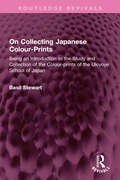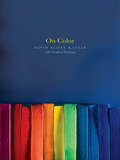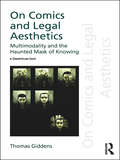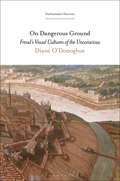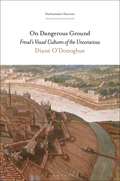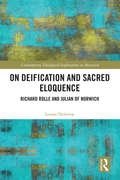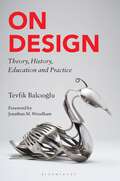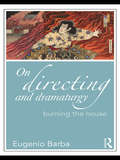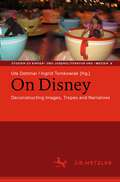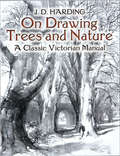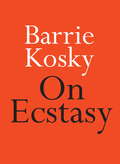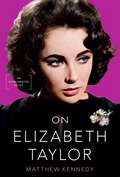- Table View
- List View
On Collecting Japanese Colour-Prints: Being an Introduction to the Study and Collection of the Colour-prints of the Ukiyoye School of Japan (Routledge Revivals)
by Basil StewartFirst published in 1917, On Collecting Japanese-Prints is meant to assist the amateur who has started a collection for the first time, or the person who, while not actually a collector, is sufficiently interested to read about the subject, yet finds the more exhaustive and advanced works thereon somewhat beyond them. How to distinguish forgeries and imitations; what prices should be given; what examples can still be obtained, are some of the questions which the writer has attempted to answer. The following chapters being primarily written for the beginner, artists whose work is very rare, or whose prints they are unlikely to come across in their search for examples, are not mentioned, unless where necessary from a historical or artistic point of view.
On Collecting Japanese Colour-Prints: Being an Introduction to the Study and Collection of the Colour-prints of the Ukiyoye School of Japan (Routledge Revivals)
by Basil StewartFirst published in 1917, On Collecting Japanese-Prints is meant to assist the amateur who has started a collection for the first time, or the person who, while not actually a collector, is sufficiently interested to read about the subject, yet finds the more exhaustive and advanced works thereon somewhat beyond them. How to distinguish forgeries and imitations; what prices should be given; what examples can still be obtained, are some of the questions which the writer has attempted to answer. The following chapters being primarily written for the beginner, artists whose work is very rare, or whose prints they are unlikely to come across in their search for examples, are not mentioned, unless where necessary from a historical or artistic point of view.
On Color
by David Kastan Stephen FarthingRanging from Homer to Picasso, and from the Iranian Revolution to The Wizard of Oz, this spirited and radiant book awakens us anew to the role of color in our lives Our lives are saturated by color. We live in a world of vivid colors, and color marks our psychological and social existence. But for all color’s inescapability, we don’t know much about it. Now authors David Scott Kastan and Stephen Farthing offer a fresh and imaginative exploration of one of the most intriguing and least understood aspects of everyday experience. Kastan and Farthing, a scholar and a painter, respectively, investigate color from numerous perspectives: literary, historical, cultural, anthropological, philosophical, art historical, political, and scientific. In ten lively and wide-ranging chapters, each devoted to a different color, they examine the various ways colors have shaped and continue to shape our social and moral imaginations. Each individual color becomes the focal point for a consideration of one of the extraordinary ways in which color appears and matters in our lives. Beautifully produced in full color, this book is a remarkably smart, entertaining, and fascinating guide to this elusive topic.
On Color
by David Scott Kastan Stephen FarthingOur lives are saturated by color. We live in a world of vivid colors, and color marks our psychological and social existence. But for all color's inescapability, we don't know much about it. Now authors David Scott Kastan and Stephen Farthing offer a fresh and imaginative exploration of one of the most intriguing and least understood aspects of everyday experience.
On Color (PDF)
by David Kastan Stephen FarthingOur lives are saturated by color. We live in a world of vivid colors, and color marks our psychological and social existence. But for all color's inescapability, we don't know much about it. Now authors David Scott Kastan and Stephen Farthing offer a fresh and imaginative exploration of one of the most intriguing and least understood aspects of everyday experience.
On Comics and Legal Aesthetics: Multimodality and the Haunted Mask of Knowing
by Thomas GiddensWhat are the implications of comics for law? Tackling this question, On Comics and Legal Aesthetics explores the epistemological dimensions of comics and the way this once-maligned medium can help think about – and reshape – the form of law. Traversing comics, critical, and cultural legal studies, it seeks to enrich the theorisation of comics with a critical aesthetics that expands its value and significance for law, as well as knowledge more generally. It argues that comics’ multimodality – its hybrid structure, which represents a meeting point of text, image, reason, and aesthetics – opens understanding of the limits of law’s rational texts by shifting between multiple frames and modes of presentation. Comics thereby exposes the way all forms of knowledge are shaped out of an unstructured universe, becoming a mask over this chaotic ‘beyond’. This mask of knowing remains haunted – by that which it can never fully capture or represent. Comics thus models knowledge as an infinity of nested frames haunted by the chaos without structure. In such a model, the multiple aspects of law become one region of a vast and bottomless cascade of perspectives – an infinite multiframe that extends far beyond the traditional confines of the comics page, rendering law boundless.
On Comics and Legal Aesthetics: Multimodality and the Haunted Mask of Knowing
by Thomas GiddensWhat are the implications of comics for law? Tackling this question, On Comics and Legal Aesthetics explores the epistemological dimensions of comics and the way this once-maligned medium can help think about – and reshape – the form of law. Traversing comics, critical, and cultural legal studies, it seeks to enrich the theorisation of comics with a critical aesthetics that expands its value and significance for law, as well as knowledge more generally. It argues that comics’ multimodality – its hybrid structure, which represents a meeting point of text, image, reason, and aesthetics – opens understanding of the limits of law’s rational texts by shifting between multiple frames and modes of presentation. Comics thereby exposes the way all forms of knowledge are shaped out of an unstructured universe, becoming a mask over this chaotic ‘beyond’. This mask of knowing remains haunted – by that which it can never fully capture or represent. Comics thus models knowledge as an infinity of nested frames haunted by the chaos without structure. In such a model, the multiple aspects of law become one region of a vast and bottomless cascade of perspectives – an infinite multiframe that extends far beyond the traditional confines of the comics page, rendering law boundless.
On Craftsmanship: Towards A New Bauhaus (Oberon Masters Ser.)
by Christopher FraylingCraftsmanship has again become fashionable in high places, just as it did in the last few recessions.The concept of craftsmanship has never been as relevant and timely as it is today. Assailed on all sides by – among many other tendencies - flexible working, short-termism, portfolio careers, quick-fix training and the cult of celebrity, it has recently re-entered public debate with a new sense of urgency. Why? This series of linked essays by the man who ran the Royal College of Art for many years explores the crafts in education, in history and literature, in the contemporary arts landscape, in the language, in the digital age, and takes an unsentimental, hard-headed look at craftsmanship today. Only when the romantic cobwebs have been blown away, it argues, can the key importance of the crafts be fully understood.
On Dangerous Ground: Freud’s Visual Cultures of the Unconscious (Psychoanalytic Horizons)
by Diane O'DonoghueIn the final years of the 19th century, Sigmund Freud began to construct evidence for the workings of an “unconscious.” On Dangerous Ground offers an innovative assessment of the complex role that his encounters with visual cultures-architecture, objects from earlier cultural epochs (“antiquities”), paintings, and illustrated books-played in that process. Diane O'Donoghue introduces, often using unpublished archival sources, the ways in which material phenomena profoundly informed Freud's decisions about what would, and would not, constitute the workings of an inner life. By returning to view content that Freud treated as forgettable, as distinct from repressed, O'Donoghue shows us a realm of experiences that Freud wished to remove from psychical meaning. These erasures form an amnesic core within Freud's psychoanalytic project, an absence that includes difficult aspects of his life narrative, beginning with the dislocations of his early childhood that he declared “not worth remembering.” What is made visible here is far from the inconsequential surface of experience; rather, we are shown a dangerous ground that exceeds the limits of what Freud wished to include within his early model of mind. In Freud's relation to visual cultures we find clues to what he attempted, in crafting his unconscious, to remove from sight.
On Dangerous Ground: Freud’s Visual Cultures of the Unconscious (Psychoanalytic Horizons)
by Diane O'DonoghueIn the final years of the 19th century, Sigmund Freud began to construct evidence for the workings of an “unconscious.” On Dangerous Ground offers an innovative assessment of the complex role that his encounters with visual cultures-architecture, objects from earlier cultural epochs (“antiquities”), paintings, and illustrated books-played in that process. Diane O'Donoghue introduces, often using unpublished archival sources, the ways in which material phenomena profoundly informed Freud's decisions about what would, and would not, constitute the workings of an inner life. By returning to view content that Freud treated as forgettable, as distinct from repressed, O'Donoghue shows us a realm of experiences that Freud wished to remove from psychical meaning. These erasures form an amnesic core within Freud's psychoanalytic project, an absence that includes difficult aspects of his life narrative, beginning with the dislocations of his early childhood that he declared “not worth remembering.” What is made visible here is far from the inconsequential surface of experience; rather, we are shown a dangerous ground that exceeds the limits of what Freud wished to include within his early model of mind. In Freud's relation to visual cultures we find clues to what he attempted, in crafting his unconscious, to remove from sight.
On Deification and Sacred Eloquence: Richard Rolle and Julian of Norwich (Contemporary Theological Explorations in Mysticism)
by Louise NelstropThis book considers the place of deification in the writings of Julian of Norwich and Richard Rolle, two of the fourteenth-century English Mystics. It argues that, as a consequence of a belief in deification, both produce writing that is helpfully viewed as sacred eloquence. The book begins by discussing the nature of deification, employing Norman Russell’s typology. It explores the realistic and ethical approaches found in the writings of several Early Greek Fathers, including Irenaeus of Lyons, Cyril of Alexandria, Origen, and Evagrius Ponticus, as well as engaging with the debate around whether deification is a theological idea found in the West across its history. The book then turns its attention to Julian and Rolle, arguing that both promote forms of deification: Rolle offering a primarily ethical approach, while Julian’s approach is more realistic. Finally, the book addresses the issue of sacred eloquence, arguing that both Rolle and Julian, in some sense, view their words as divinely inspired in ways that demand an exegetical response that is para-biblical. Offering an important perspective on a previously understudied area of mysticism and deification, this book will be of interest to scholars of mysticism, theology, and Middle English religious literature.
On Deification and Sacred Eloquence: Richard Rolle and Julian of Norwich (Contemporary Theological Explorations in Mysticism)
by Louise NelstropThis book considers the place of deification in the writings of Julian of Norwich and Richard Rolle, two of the fourteenth-century English Mystics. It argues that, as a consequence of a belief in deification, both produce writing that is helpfully viewed as sacred eloquence. The book begins by discussing the nature of deification, employing Norman Russell’s typology. It explores the realistic and ethical approaches found in the writings of several Early Greek Fathers, including Irenaeus of Lyons, Cyril of Alexandria, Origen, and Evagrius Ponticus, as well as engaging with the debate around whether deification is a theological idea found in the West across its history. The book then turns its attention to Julian and Rolle, arguing that both promote forms of deification: Rolle offering a primarily ethical approach, while Julian’s approach is more realistic. Finally, the book addresses the issue of sacred eloquence, arguing that both Rolle and Julian, in some sense, view their words as divinely inspired in ways that demand an exegetical response that is para-biblical. Offering an important perspective on a previously understudied area of mysticism and deification, this book will be of interest to scholars of mysticism, theology, and Middle English religious literature.
On Design: Theory, History, Education and Practice
by Tevfik BalciogluThis volume presents for the first time a curated selection of essays written over the last 30 years by leading design thinker and educator, Tevfik Balcioglu. With a focus on Turkish and British design, his writing examines questions of national and transnational design history and provides a critical insight into contemporary global design issues.Structured into four thematic sections with contextualizing introductions, this anthology addresses various aspects of design history, theory, education and practice. Essays look at the impact of industrialization and globalization on design cultures and highlight local and global design developments from the late 20th century to the present day. They cover reproduction techniques and technological progress in recent decades, the changing nature of mass-produced objects and the introduction of new methods, systems, shapes, forms and styles over time.Addressing issues relating to education and practice, case studies draw on Balcioglu's work at various institutions such as Izmir University of Economics, Turkey where he established a faculty of design departments and introduced a new model of integrated programmes, and Kent University, UK where he established the BA (Hons) 3D Design course. His writing explores the nature and transferability of knowledge in the design field through critical analysis of the emergence of new degree programmes, the evolution of design education and the relationship between theory and practice.
On Design: Theory, History, Education and Practice
by Tevfik BalciogluThis volume presents for the first time a curated selection of essays written over the last 30 years by leading design thinker and educator, Tevfik Balcioglu. With a focus on Turkish and British design, his writing examines questions of national and transnational design history and provides a critical insight into contemporary global design issues.Structured into four thematic sections with contextualizing introductions, this anthology addresses various aspects of design history, theory, education and practice. Essays look at the impact of industrialization and globalization on design cultures and highlight local and global design developments from the late 20th century to the present day. They cover reproduction techniques and technological progress in recent decades, the changing nature of mass-produced objects and the introduction of new methods, systems, shapes, forms and styles over time.Addressing issues relating to education and practice, case studies draw on Balcioglu's work at various institutions such as Izmir University of Economics, Turkey where he established a faculty of design departments and introduced a new model of integrated programmes, and Kent University, UK where he established the BA (Hons) 3D Design course. His writing explores the nature and transferability of knowledge in the design field through critical analysis of the emergence of new degree programmes, the evolution of design education and the relationship between theory and practice.
On Directing and Dramaturgy: Burning the House
by Eugenio Barba"A theatre which is able to speak to each spectator in a different and penetrating language is not a fantastic idea, nor a utopia. This is the theatre for which many of us, directors and leaders of groups, trained for a long time....." - from the Introduction On Directing is Eugenio Barba's unprecedented account of his own life and work. This is a major retrospective of Barba's working methods, his practical techniques, and the life experiences which fed directly into his theatre-making. On Directing is an inspirational resource. It is a dramaturgy of dramaturgies, and a professional autobiography, from one of the most significant and influential directors and theorists working today. It provides unique insights into a philosophy and practice of directing for the beginning student, the experienced practitioner, and everyone in between.
On Directing and Dramaturgy: Burning the House
by Eugenio Barba"A theatre which is able to speak to each spectator in a different and penetrating language is not a fantastic idea, nor a utopia. This is the theatre for which many of us, directors and leaders of groups, trained for a long time....." - from the Introduction On Directing is Eugenio Barba's unprecedented account of his own life and work. This is a major retrospective of Barba's working methods, his practical techniques, and the life experiences which fed directly into his theatre-making. On Directing is an inspirational resource. It is a dramaturgy of dramaturgies, and a professional autobiography, from one of the most significant and influential directors and theorists working today. It provides unique insights into a philosophy and practice of directing for the beginning student, the experienced practitioner, and everyone in between.
On Directing Shakespeare (Routledge Library Editions: Shakespeare in Performance)
by Ralph BerryFor producers and directors planning a production, several questions inevitably arise: Which play is appropriate for the contemporary audience? Should the text and setting be altered? Twelve leading contemporary directors answer these questions in interviews in this book and shed light on what Shakespeare means to them and to their audiences. Originally published in 1977.
On Directing Shakespeare (Routledge Library Editions: Shakespeare in Performance)
by Ralph BerryFor producers and directors planning a production, several questions inevitably arise: Which play is appropriate for the contemporary audience? Should the text and setting be altered? Twelve leading contemporary directors answer these questions in interviews in this book and shed light on what Shakespeare means to them and to their audiences. Originally published in 1977.
On Discomfort: Moments in a Modern History of Architectural Culture (Ashgate Studies in Architecture)
by David Ellison Andrew LeachExamining discomfort’s physical, emotional, conceptual, psychological and aesthetic dimensions, the contributors to this volume offer an alternate, cultural approach to the study of architecture and the built environment. By attending to a series of disparate instances in which architecture and discomfort intersect, On Discomfort offers a fresh reading of the negotiations that define architecture’s position in modern culture. The essays do not chart comfort’s triumph so much as discomfort’s curious dispersal into practices that form ‘modern life’ – and what that dispersion reveals of both architecture and culture. The essays presented in this volume illuminate the material culture of discomfort as it accrues to architecture and its history. This episodic analysis speaks to a range of disciplinary fields and interdisciplinary subjects, extending our understanding of the domestication of interiors (and objects, cities and ideas); and the conditions under which – by intention or accident – they discomfort.
On Discomfort: Moments in a Modern History of Architectural Culture (Ashgate Studies in Architecture)
by David Ellison Andrew LeachExamining discomfort’s physical, emotional, conceptual, psychological and aesthetic dimensions, the contributors to this volume offer an alternate, cultural approach to the study of architecture and the built environment. By attending to a series of disparate instances in which architecture and discomfort intersect, On Discomfort offers a fresh reading of the negotiations that define architecture’s position in modern culture. The essays do not chart comfort’s triumph so much as discomfort’s curious dispersal into practices that form ‘modern life’ – and what that dispersion reveals of both architecture and culture. The essays presented in this volume illuminate the material culture of discomfort as it accrues to architecture and its history. This episodic analysis speaks to a range of disciplinary fields and interdisciplinary subjects, extending our understanding of the domestication of interiors (and objects, cities and ideas); and the conditions under which – by intention or accident – they discomfort.
On Disney: Deconstructing Images, Tropes and Narratives (Studien zu Kinder- und Jugendliteratur und -medien #9)
by Ute Dettmar Ingrid TomkowiakDisney – This name stands not only for a company that has had global reach from its early days, but also for a successful aesthetic programme and ideological positions that have had great commercial success but at the same time have been frequently criticised. Straddling traditionalism and modernism, Disney productions have proven adaptable to social discourses and technical and media developments throughout its history. This volume brings together scholars from several European countries to explore various dimensions that constitute ‘Disney.’ In line with current media and cultural studies research, the chapters deal with human-human and human-animal relations, gender and diversity, iconic characters and narratives, Disney’s contribution to cultural and visual heritage, and transmedial and transfictional spaces of experience and practices of participation associated with Disney story worlds.
On Drawing Trees and Nature: A Classic Victorian Manual with Lessons and Examples
by J. D. HardingThis classic of art instruction is the work of James Duffield Harding (1798-1863), who served as drawing master and sketching companion to the great Victorian art critic, John Ruskin. Generations of students have benefited from the teachings of this 19th-century master, who sought always to "produce as near a likeness to Nature, in every respect, as the instrument, or material employed, will admit of; not so much by bona fide imitation, as by reviving in the mind those ideas which are awakened by a contemplation of Nature . . . The renewal of those feelings constitutes the true purpose of Art."This volume consists of direct reproductions of Harding's sketches of vignettes from natural settings. Each is accompanied by a series of lessons emphasizing both practical and theoretical considerations. The edition features the added attraction of 23 outstanding plates from the author's Lessons on Trees.
On Ecstasy (On Series)
by Barrie Kosky'My polish grandmother made a chicken soup like no other chicken soup. To this day, it has, to my knowledge and experience, never been bettered ... Her chicken soup was the Caravaggio of soups. The Rainer Marie Rilke of soups. The Arturo Benedetti Michelangeli of soups.'A compelling and entertaining stoyteller, Barrie Kosky explores the feelings of intense joy and delight, as well as the power and terror that is ecstasy.
On Elizabeth Taylor: An Opinionated Guide
by Matthew KennedyA sweeping look at the career of a truly singular Hollywood star In the oceans of ink devoted to the monumental movie star/businesswoman/political activist Elizabeth Rosemond Taylor (1932-2011), her beauty and not-so-private life frequently overshadowed her movies. While she knew how to generate publicity like no other, her personal life is set aside in this volume in favor of her professional oeuvre and unique screen dynamism. In On Elizabeth Taylor: An Opinionated Guide, her marriages, illnesses, media firestorms, perfume empire, violet eyes, and AIDS advocacy take a back seat to Elizabeth Taylor, the actress. Taylor's big screen credits span over fifty years, from her pre-adolescent debut in There's One Born Every Minute (1942) to her cameo in The Flintstones (1994). She worked steadily in everything from the biggest production in film history (Cleopatra in 1963) to a humble daytime TV soap opera (General Hospital in 1981). Each of her sixty-seven film appearances is recapped here with background on their inception, production, release, and critical and financial outcome. On Elizabeth Taylor: An Opinionated Guide is a cradle-to-grave chronology of Taylor's life, noting key events, achievements, and milestones. This book offers a work-by-work analysis of her entire career told in chronological order, each film headlined with year of release, distributing studio, and director. This in-depth overview provides an invaluable new way of understanding Taylor's full life and work, as well as the history and nuances of the film industry as it existed in the twentieth century. Kennedy engagingly reassesses Taylor's acting and the nuances she brought to the screen - this includes a consideration of her specific art, the development of her voice, her relationship to the camera, and her canny understanding of the effect she had on audiences worldwide. Kennedy also provides an elucidating guide to her entire filmography, one that speaks to the quality of her performances, their contours and shading, and their context within her extraordinary life and career. On Elizabeth Taylor is a beautifully comprehensive overview of a singular actress of the twentieth century, offering new ways to see and appreciate her skill and peerless charisma, in turn placing her among the greatest film stars of all time.
